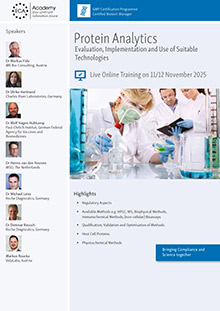Update of Training Material for ICH Q8, Q9 and Q10

Recommendation
5/6 February 2026
In a detailed news article in late 2023, we drew attention to the new training package for the revision of the ICH Q9 guideline (quality risk management). With a total of over 300 slides, it is a very comprehensive document. The ICH has now published updated training material on the implementation of ICH Q8, Q9 and Q10. What is new?
The material was originally based on workshop slides from 2010, created by members of the ICH Q8/9/10 Implementation Group. Parts of these slides have also been incorporated into this new training material. The slides have been updated to better incorporate quality risk management approaches in line with the revision of ICH Q9. A large portion of the 2010 slides were aimed at product and process development. This remains the case with the updated training material.
Table of contents
The 57 slides are divided into 3 chapters:
- The Pharmaceutical Quality System (PQS) as a framework for ICH Q8, Q9 and Q10. It describes the context of the three guidelines and the benefits they offer. It also presents PQS as a framework and discusses the life cycle approach and quality risk management (QRM).
- The pharmaceutical quality system during the development process (ICH Q8). The use of QRM and the implementation of a control strategy are described. The chapter also deals with process design and the initial design space.
- The pharmaceutical quality system in commercial manufacturing. The chapter deals with the production itself and with inspections, as well as with the life cycle within the framework of QRM and continuous improvement.
Chapter 1
The essence of the first chapter is that the ICH Q8, Q9 and Q10 guidelines should be seen as an integrated system, with each guideline providing specific details to support product realization and a life cycle that remains in the state of control.
Chapter 2 - The PQS in development
In the second chapter, the development process is explained in detail on 13 slides, starting with the Quality Target Product Profile (QTPP) through to Critical Quality Attributes (CQA) and Critical Process Parameters (CPP) right up to the Control Strategy. Design of Experiments and, of course, existing knowledge from the past are recommended as aids in the development process.
On 7 slides, a practical example in the area of solid dosage forms shows the use of risk assessment in order to define the control strategy, which in turn ensures that the CQAs are assured. Risk matrices (initial and detailed) are shown using the traffic light principle. The result is a preliminary control strategy, which is then confirmed during scale-up and process validation. An alternative approach using process analytical technologies is compared with the classic development approach. This comparison is illustrated in terms of the two possible control strategies.
A final overview slide then summarizes the chapter: The example shows the correlation between risk management ICH Q9(R1), process understanding (ICH Q8(R2) and the use of knowledge of ICH Q10 to arrive at a control strategy.
Chapter 3 - The PQS in technology transfer and commercial production
Individual slides cover aspects such as
- Securing the "State of Control" through the PQS
- Scale-up and technology transfer
- Process validation
- Overview by senior management
- Continuous improvement process and change management
- Legacy products and
- an example.
The final example shows inspection-relevant considerations when using a near-infrared (NIR) system as a PAT application for monitoring the content uniformity of a tablet product as part of a real-time release application.
Conclusion: The slides are helpful with the adaptations. Particularly noteworthy is the example of the development process leading to the control strategy.
The link to the slides is available on the ICH website.





